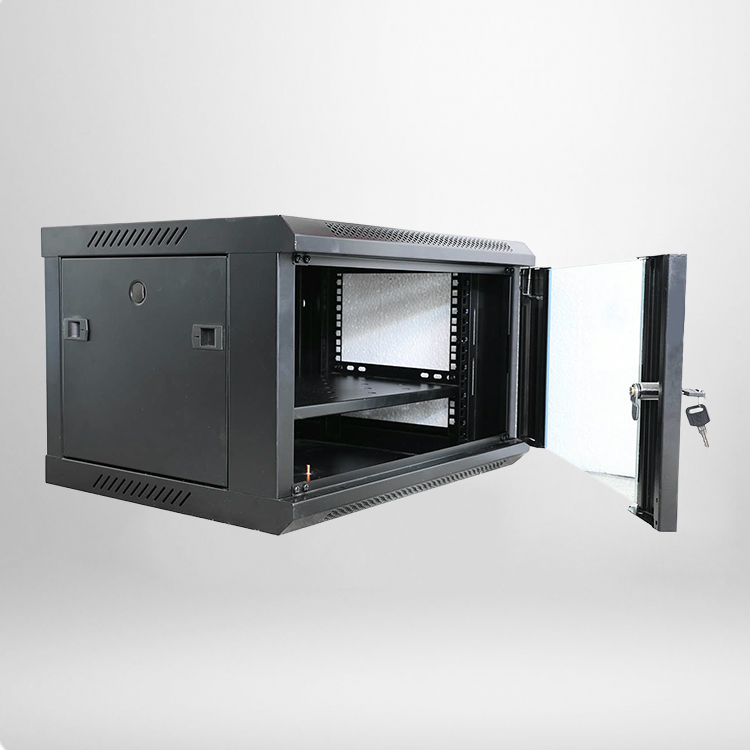
In the ever – evolving world of networking, efficient space utilization and equipment protection are crucial. Wall mount network cabinets have emerged as a practical solution, offering a blend of functionality, convenience, and space – saving design.
Design and Construction
Wall mount network cabinets are typically constructed from durable materials such as cold – rolled steel. This material choice ensures the cabinets can withstand the rigors of regular use, protecting sensitive network equipment from physical damage. For example, many cabinets are made of high – grade SPCC (Steel Plate Cold Coil), which is known for its strength and stability. The surface of these cabinets often undergoes electrostatic powder spray treatment. This not only provides an attractive finish but also enhances corrosion resistance, making the cabinets suitable for various environmental conditions.
The cabinets come in different sizes and configurations. Standard 19 – inch network cabinets are a common choice, as they are compatible with a wide range of 19 – inch devices, including network switches, patch panels, and small servers. They are available in various heights, such as 4U, 6U, 9U, 12U, 18U, and 24U, and depths like 450 mm, 600 mm, 762 mm, and even some with a low – profile 12 – inch or 18 – inch depth. This variety allows for customization based on the specific needs of the network installation.
Cable Management Features
Cable management is a key aspect of any network setup, and wall mount network cabinets are designed with this in mind. They often feature integrated vertical cable management on both the front and rear. This allows for the neat and organized routing of patch cords and incoming cables. For instance, there are channels or clips that keep the cables in place, preventing tangling and making it easier to identify and troubleshoot connections.
Some cabinets also have top and bottom plates with knock – out blanking plates. These make it convenient to enter cables into the cabinet. Additionally, a 5×5 rear entry opening is available in certain models to support in – wall cabling, further enhancing the cable management options.

Accessibility and Security
Accessibility is a major advantage of wall mount network cabinets. Many cabinets have a right – or left – hinged back plate design. This provides easy rear access to equipment and wiring, which is extremely useful during installation, maintenance, and upgrades. For example, in a network closet where frequent access to the back of the equipment is required, a hinged back plate allows technicians to quickly reach the components without having to remove the entire cabinet.
Security is also a priority. Most wall mount network cabinets come with a lockable front door, which can be made of tempered glass or solid metal. The glass door provides visibility into the cabinet, allowing for easy monitoring of the equipment status, while still maintaining security. Locks on the front, side, and rear (if applicable) protect the valuable network equipment from unauthorized access, tampering, and theft.
Load – Bearing Capacity
The load – bearing capacity of wall mount network cabinets varies depending on the model. Some cabinets are designed to support a significant amount of weight, with load ratings of up to 300 lb in select models. This makes them suitable for applications where heavier network or IoT (Internet of Things) equipment needs to be mounted. However, it’s important to note that the weight capacity of a wall – mounted network cabinet typically ranges around 60 kg to 200 lbs, depending on the specific design and construction. When choosing a cabinet, it’s crucial to consider the weight of the equipment that will be placed inside to ensure safe and stable installation.
Ventilation and Cooling
Proper ventilation and cooling are essential for the optimal performance of network equipment. Wall mount network cabinets are designed with this in mind. Air vents are provided on each plate, such as the top, bottom, and side panels, to facilitate air circulation. This helps to dissipate heat generated by the network equipment, preventing overheating and potential equipment failures.
In some cases, additional cooling options are available. For example, some cabinets are pre – equipped with fan units that can be installed from top to bottom. These fans can be easily disassembled and assembled for maintenance. The fans draw in cool air from the outside and expel hot air, ensuring that the internal temperature of the cabinet remains within the optimal range for the network equipment.


